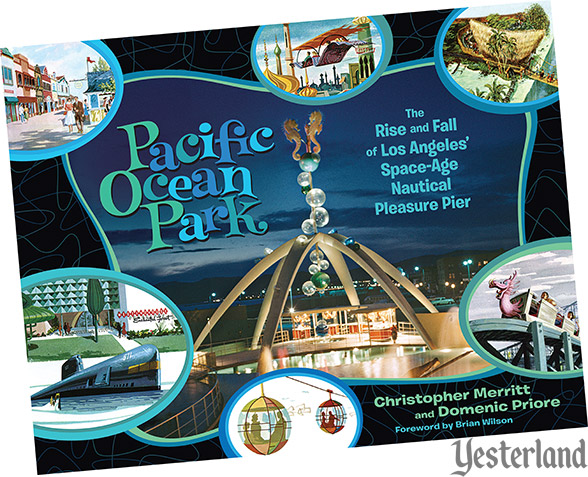|
Book Review |
Pacific Ocean Park The Rise and Fall of Los Angeles’ |
||
|
|||
|
|
|||
|
I first became aware that Chris Merritt was working on a book about Pacific Ocean Park when I met him at Knott’s Berry Farm in 2009 at the event celebrating the publication of the book that he and J. Eric Lynxwiler wrote about Knott’s. I observed that it would be much harder for a book about P.O.P. to find an audience. There are people of all ages who have enjoyed Knott’s over the course of many decades, right up to the present day, and who still care about Knott’s. But P.O.P. is largely a forgotten footnote in Southern California attraction history. It’s not what Chris wanted to hear. |
|||
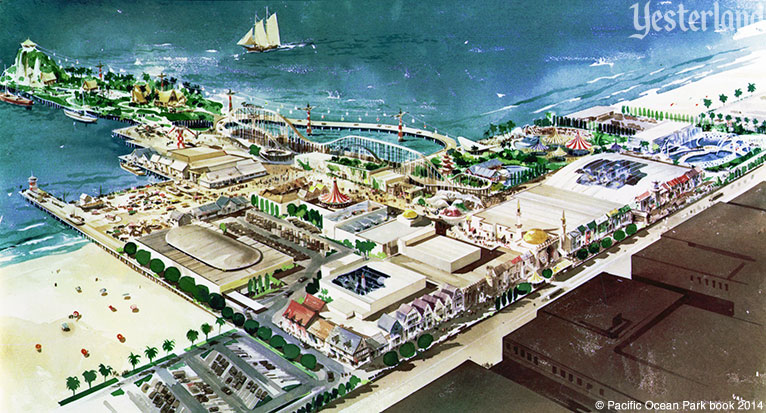
Historical image © Pacific Ocean Park Book 2014. 2014 Pacific Ocean Park concept art |
|||
|
Five years after the event at Knott’s, co-authors Chris Merritt and Domenic Priore have released their book about Pacific Ocean Park. In this review, I’ll tell you why this book should find an audience—why you should enjoy this book if you care about theme parks, even if you never visited or even heard of Pacific Ocean Park before. |
|||
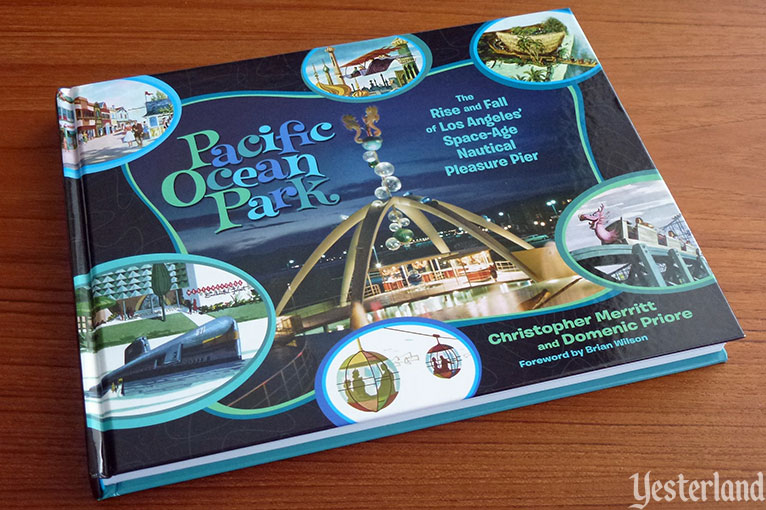
Book cover © Pacific Ocean Park Book 2014. Photo by Werner Weiss, 2014 The new book |
|||
|
For the price of this book, you can now go back in time. You can visit the park that tried to bring together the best aspects of a traditional seaside amusement pier and the kind of art direction introduced by Disneyland, 35 miles to its southeast. |
|||
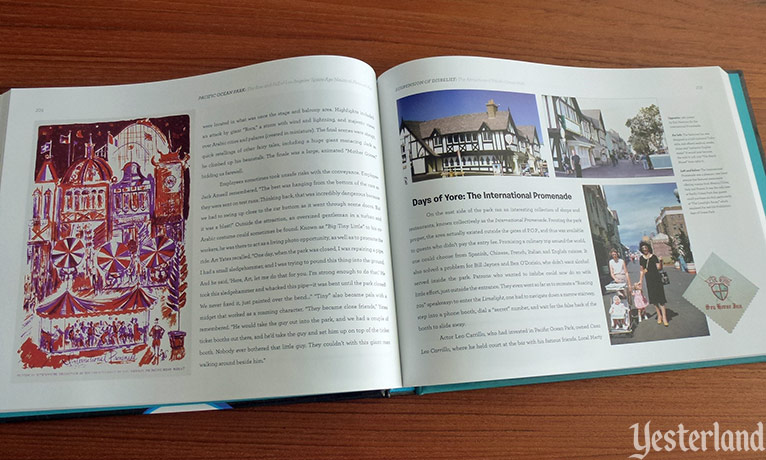
Book content © Pacific Ocean Park Book 2014. Photo by Werner Weiss, 2014 Sample pages |
|||
|
Most pages have images and text. Some pages have only images. There must be around 700 or 800 images—including historical photos, concept art, design diagrams, advertisements, and brochures—although I didn’t count them. But it’s not just a picture book. It’s obvious that a tremendous amount of research has gone into this book. There’s a good balance between history, anecdotes, first-hand recollections, and descriptions of the guest experience. |
|||
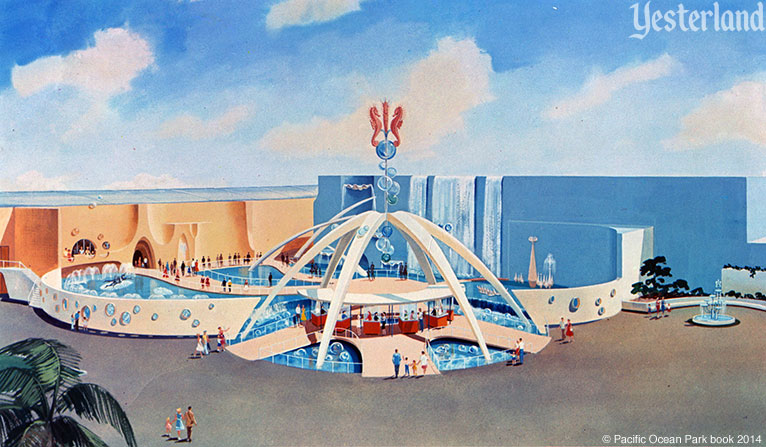
Historical image © Pacific Ocean Park Book 2014 Concept art for Pacific Ocean Park’s main entrance |
|||
|
You’ll meet the business people and art directors who made the park happen. You can imagine yourself riding the rides, seeing the shows, and walking through the disjointed—sort-of-a-theme-park, sort-of-an-amusement-park—atmosphere. As you read about the park deteriorating over its short lifespan, you can think about whether its failure was inevitable or could have been prevented. And, just as in a good novel, there are unexpected surprises and “plot twists” to keep things fun and interesting—even though you know how the story will end. |
|||
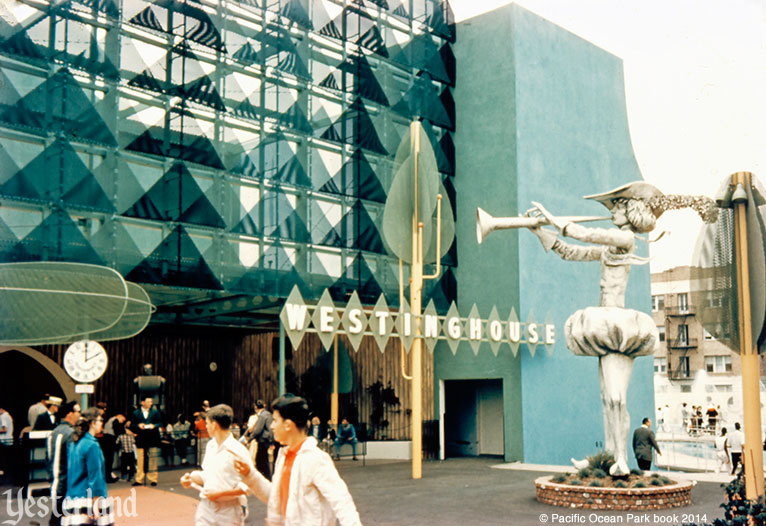
Historical image © Pacific Ocean Park Book 2014 Westinghouse Enchanted Forest |
|||
|
I’ve been to Pacific Ocean Park twice. The first time was in 1958 or 1959, when I visited the seaside park as a child with my parents. The second time was this week, thanks to this wonderful book. I don’t remember much about my first visit. It was a short visit. We visited a free exhibit and went on one ride that required a paid ticket. I remember the free Westinghouse Enchanted Forest. It was the type of thing you might have expected to find in Tomorrowland and Disneyland in those days. The hosts were Jack and Jill, the Mother Goose characters. An entire House of the Future built itself in front of your eyes, with Westinghouse electric appliances and other parts of the house seemingly appearing out of nowhere. I was mesmerized by the magic in front of me. The attraction also included a walk through a replica of part of the nuclear submarine Nautilus. Westinghouse made everything from washing machines to atomic reactors in those days. |
|||
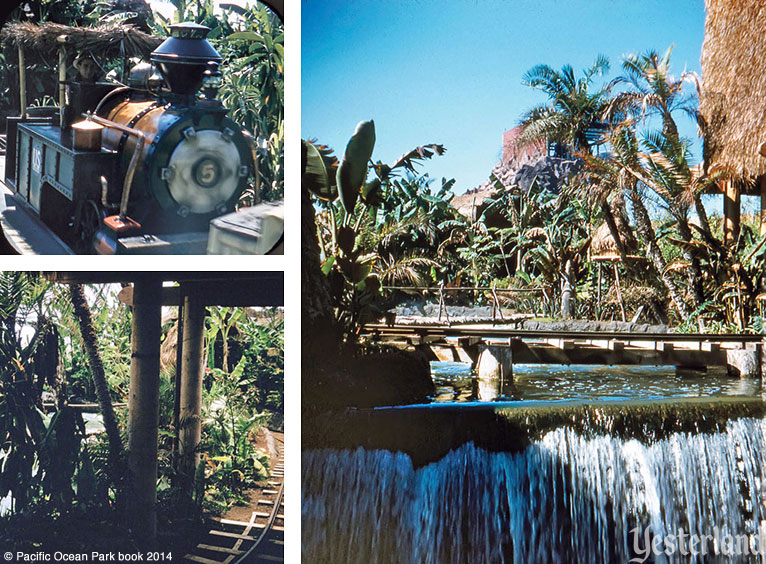
Historical image © Pacific Ocean Park Book 2014 Mystery Island Banana Train |
|||
|
My parents told me the Banana Train would be like Disneyland’s Jungle Cruise, only with trains instead of boats. After taking the ride, we all agreed the Jungle Cruise was better. |
|||
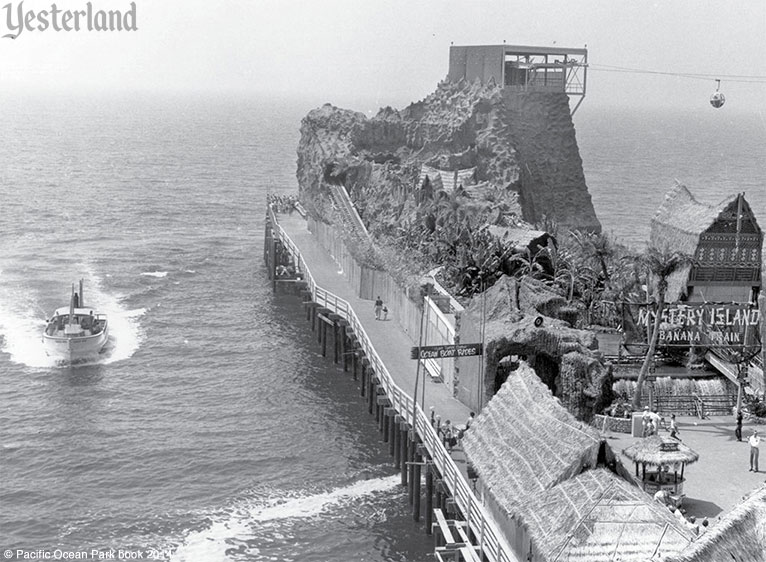
Historical image © Pacific Ocean Park Book 2014 Mystery Island Banana Train at the end of the pier |
|||
|
Now, after reading the book, I realize what an amazing place the Mystery Island Banana Train was. The tropical jungle, volcano, and indoor-outdoor train ride was at the end of the pier. Guests reached the “island” on a suspension bridge over a waterfall. |
|||
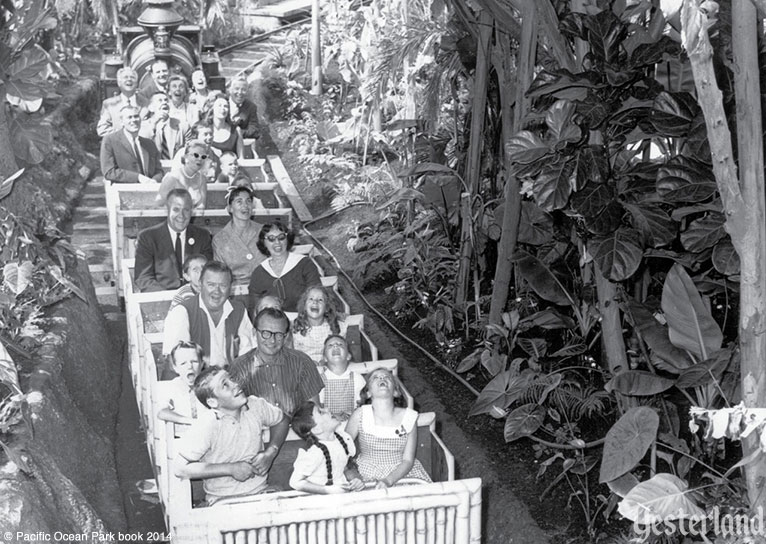
Historical image © Pacific Ocean Park Book 2014 On the Banana Train |
|||
|
Even if the Jungle Cruise was better, the descriptions of the Banana Train are fascinating. |
|||
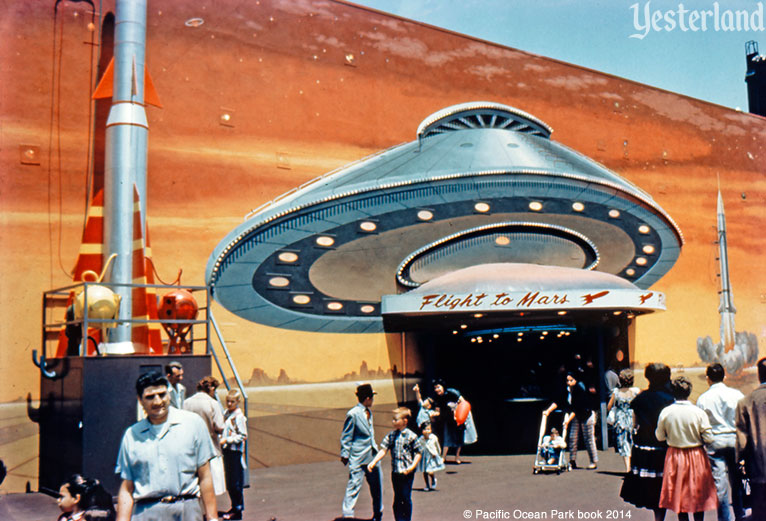
Historical image © Pacific Ocean Park Book 2014 Flight to Mars |
|||
|
Flight to Mars tried to be better than Disneyland’s Rocket to Moon. For one thing, guests actually arrived at the destination and disembarked there. Continuing with comparisons to Disneyland attractions, the Ocean Highway was P.O.P.’s answer to the Autopia, while the Ocean Skyway provided a Skyway experience. The P.O.P. versions both traveled above the ocean—with a slight thrill factor of knowing that if something went wrong, you would plunge deep into the water below. |
|||
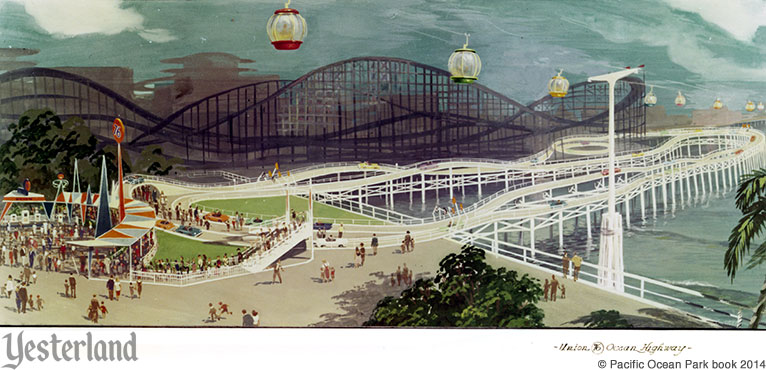
Historical image © Pacific Ocean Park Book 2014 Ocean Highway and Ocean Skyway |
|||
|
The book describes all the other attractions of Pacific Ocean Park, but that is only one part of the book. One way to look at it is that although the book has 264 pages and the story is told chronologically, the park does not open for business until page 68 and goes out out of business on page 211. Unlike Disneyland, which was built in orange groves, Pacific Ocean Park was built on two adjacent existing amusement piers. Those piers and their histories are part of the story. P.O.P. kept numerous buildings and even some rides from those piers. Chris Merritt is a theme park designer, so there’s plenty about the design work that went into the transformation into P.O.P. Even while the park was open, its heyday was brief. After getting off to what seemed to be a good start in 1958, Pacific Ocean Park struggled. It closed permanently in 1967. (In comparison, Disneyland has prospered for 59 years.) In the 1960s, the park deteriorated because the cash flow wasn’t there for proper maintenance and certainly not for new attractions to draw more guests. Despite never pulling the attendance it was supposed to, P.O.P. gained fame from television dance shows broadcast from the park. P.O.P. became a dance music mecca for teenagers. The book also provides many details about the acts that played the park’s Aragon Ballroom, which became the Cheetah. The story doesn’t end in 1967 either. Damage from the elements and a series of fires ate away at what remained of the park from 1967 to 1975, when the ruins were finally demolished. Photos of the charred carcass of the pier stand in stark contrast to the photos of the park in its heyday. Although paying guests had long departed, a population of surfers and homeless people relied on the ruins. There’s no historic marker on the California coast where Venice and Santa Monica meet—where Pacific Ocean Park once reached into the ocean, with tropical Mystery Island at its tip. But there is a fitting tribute to the park. It’s Pacific Ocean Park: The Rise and Fall of Los Angeles’ Space-Age Nautical Pleasure Pier. And you don’t even have to find a parking space at the beach to enjoy it on a summer weekend. |
|||
|
About the Authors Christopher Merritt currently designs theme parks in Asia and also co-wrote Knott’s Preserved: From Boysenberry to Theme Park, The History of Knott’s Berry Farm. Domenic Priore also co-wrote the celebrated volumes Riot on Sunset Strip, Pop Surf Culture, and Smile: The Story of Brian Wilson’s Lost Masterpiece. |
|||
|
Where to Buy the Book You can buy Pacific Ocean Park: The Rise and Fall of Los Angeles’ Space-Age Nautical Pleasure Pier from Amazon, other online booksellers, and many book stores. If you use the link or banner below, Yesterland earns an advertising fee from Amazon.
Pacific Ocean Park: The Rise and Fall of Los Angeles’ Space Age Nautical Pleasure Pier (Hardcover) |
|||
|
|
|||
|
|
|||
|
|
|||
© 2014 Werner Weiss — Disclaimers, Copyright, and Trademarks Updated December 19, 2014. Disclosure per FTC guidelines: Werner Weiss purchased Pacific Ocean Park: The Rise and Fall of Los Angeles’ Space-Age Nautical Pleasure Pier. Mr. Weiss did not receive an review copy and does not receive any financial consideration from Christopher Merritt, Domenic Priore, or Process Media. Yesterland is a participant in the Amazon Services LLC Associates Program, an affiliate advertising program designed to provide a means for sites to earn advertising fees by advertising and linking to Amazon.com. |
|||
